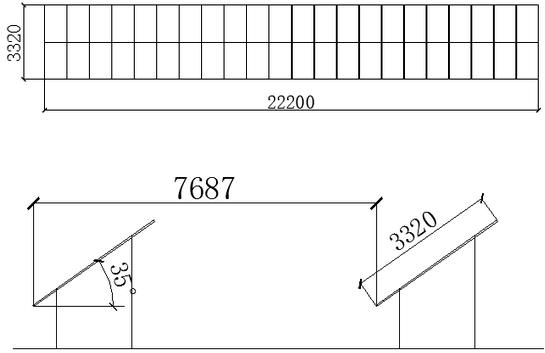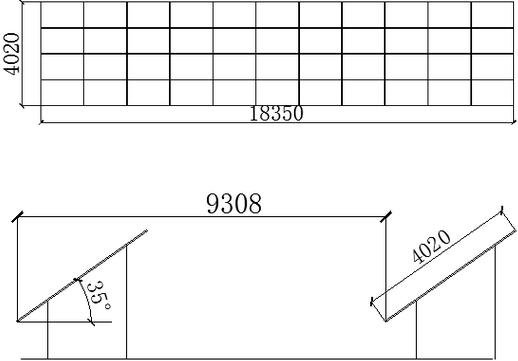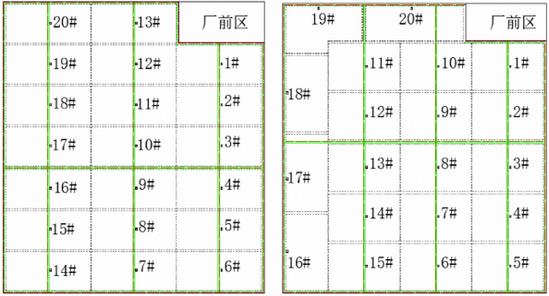I often see articles about the vertical and horizontal arrangement of photovoltaic modules on photovoltaic support units on the Internet. The article comparing the two often discusses several points: 1. Area occupied; 2. The amount of steel used for the support unit; 3 1. Installation convenience; 4. Difference in power generation. A recent article, "Photovoltaic modules have a lot of controversy in horizontal and vertical rows, and we must know how to do it," gave opinions on the above aspects and differences in convenience of operation and maintenance. It is "the components of the horizontal and vertical layouts are almost divided (should be" almost no difference "). Remarks: The occupied area does not refer to the projected area of ​​photovoltaic modules on the ground, but refers to the average area in a large-scale photovoltaic square array, including the gap area between arrays, etc.
In the past design process of the author, I have also compared the difference between the vertical and horizontal rows of photovoltaic modules and the difference in steel consumption. When considering the shadow of morning and evening, the horizontal modules have advantages over the vertical modules in terms of power generation output. In some projects, four horizontal rows of photovoltaic modules are used. But this article makes a detailed analysis based on the difference between the vertical and horizontal photovoltaic modules, in order to readers.
1. Explanation of general vertical and horizontal arrangement of components
The size of the photovoltaic modules used is 60 cells at 1650mm * 990mm * 40mm (slightly different from different manufacturers), 72 cells at 1960mm * 990mm * 40mm (slightly different from different manufacturers). The vertical row of photovoltaic modules is the long side of the module placed up and down. After the module is tilted, the long side is the north-south direction. The horizontal row of photovoltaic modules is the long side in the east-west direction. Generally, in photovoltaic power plants, the photovoltaic modules are arranged in vertical double rows, horizontal three or four rows. In recent years, there are other vertical and horizontal multi-row arrangements in agricultural photovoltaic complementary greenhouses and carport photovoltaic power plants.
2. The difference in floor space between the vertical and horizontal arrangement of components
We usually say that the vertical and horizontal arrangement of photovoltaic modules does not make much difference in the area of ​​photovoltaic power plants, but some engineers believe that the horizontal arrangement of photovoltaic modules will occupy a larger space. But the difference in area caused by different arrangements is not so bad. Where is the difference? Why do some engineers think that horizontal layout will occupy more space? Next, we explain these two issues through rigorous analysis.
(1) Vertical placement and horizontal placement of single module
According to the "Code for Design of Photovoltaic Power Stations", the photovoltaic arrays are not obstructed from 9:00 to 15:00 at the local true solar time. If we select a photovoltaic module in the photovoltaic power plant, the area of ​​the front and back rows occupied by this photovoltaic module is the projected area + the net spacing area between the arrays.

Figure 4 Side view of photovoltaic module layout
Assuming that the length of the photovoltaic module is a, the width b, the installation angle of the module is θ, and the north-south shadow coefficient of the project location is R, according to the calculation formula of the front and rear spacing of the photovoltaic array, the formula is the width of the upper and lower ends of the array.
![]()
For the footprint of a component, it should be:
Vertical component placement:

Vertical component placement:
![]()
Therefore, we can see that the above parameters are known, and the expression formula is the same, the footprint of the single component is the same.
(2) Vertical and horizontal rows of components in the photovoltaic array
This article takes a photovoltaic power plant project in Zhongwei City, Ningxia Autonomous Region as an example, and compares the calculation of photovoltaic modules with two vertical rows and four horizontal rows.
The 260Wp photovoltaic module is installed on the support unit at a 35 ° inclination angle. The array size, area and front-to-rear spacing of different arrangements are calculated as follows:

Figure 5 2 × 22 vertical arrangement of photovoltaic modules

Figure 6 Horizontal 4 × 11 arrangement of photovoltaic modules
Table 1 Comparison of the floor area of ​​different arrangements of a single array 
From the above table, we can see that the layout of the four rows in the horizontal direction has the largest array area due to the increased clearance. Although it is only 0.063 square meters, there seems to be almost no difference. As the width of the array in the horizontal four-row arrangement is increased, the center distance of the theoretical calculation of the response is also increased, and the difference is 1.621m. Through calculation, the difference in the area of ​​the array of a single support unit is 0.1504m2, and the difference is also Not big. If tens of kilowatts or hundreds of kilowatts are built in a limited area, the total area of ​​the photovoltaic square array should not be significantly different.
(3) Comparison of vertical and horizontal 1MW photovoltaic modules
This article takes a photovoltaic power plant project in Zhongwei City, Ningxia Autonomous Region as an example. Based on the data calculated above, a 1MW founder, a photovoltaic inverter and a box-shaped sub-array of modular transformers located at the center of the square array are arranged at the theoretically calculated center spacing. , With the road as a symmetry, the maintenance channel of the east and west adjacent bracket units is set to 1m uniformly. In the 1MW sub-square matrix, it consists of 95 sets of support units. Two PV strings are installed on one set of support units, for a total of 190 strings. Each 22 pieces of 260Wp modules are connected in series to form a string, for a total of 4180 pieces of modules 108.6KW.

Figure 7 2 × 22 vertical array of photovoltaic modules with 1MW sub-square array

Fig. 8 2 × 44 arrangement of photovoltaic modules with 1MW sub-square array
Table 2 Comparison of occupied area of ​​1MW square array with different layouts 
From the figures in the table above, it seems that the horizontal four rows have a lot more area. In fact, it can be decomposed into three parts: the increase in the area of ​​95 arrays results in a difference in area of ​​about 14 square meters, and the north and south widths of the square array Increase (although the width and number of the east-west spacing of adjacent arrays are the same, but the increase of the width of the north and south of the horizontal array of 1MW sub-squares will increase the area S = 7 * 19.46 = 136.22 square meters), the square array Differences in road length (increasing the width of the 1MW sub-square array arranged in four horizontal rows also causes the road to be longer and the corresponding area also increases). Therefore, the four-row horizontal array of 1MW square array theoretically increases 288.176 square meters than the vertical two-row layout.
Assuming that the inverter and the box transformer are placed on the edge of the sub-square matrix, not in the middle, and the sub-square matrix does not consider the road, then Table 2 is adjusted to Table 3, and the 1MW sub-square matrix does not consider the road impact, and the area is as shown in Table 3. .
Table 3 Comparison of land area without considering the different layout methods of 1MW square matrix of roads 
However, because of the actual engineering design, the spacing between the arrays will not be designed with the theoretically calculated critical value, and it will often increase the redundancy of 0.5 meters (the specific redundancy is determined according to the design of the project and the photovoltaic engineer) to adapt to the terrain Changes and engineering errors. Adjust Table 2 as follows:
Table 4 Comparison of the floor area of ​​1MW square array with different layout considering the spacing margin 
After the photovoltaic array spacing is increased by 0.5m redundancy, because the components are arranged vertically, the east-west length of the 1MW square array is longer, so the increased area is larger. For comparison, the horizontal four rows of the 1MW square array are arranged more than the vertical double rows. The theory should be increased by 103.376 square meters.
Through the above multiple tables, if the photovoltaic system design engineers and photovoltaic practitioners think that in a large-scale photovoltaic power plant, the layout of the horizontal four rows of photovoltaic modules will definitely occupy a lot more area than the layout of the vertical double rows, then it is wrong, then Let's analyze what difference will be made to the area of ​​a specific project?
(4) Comparison of floor space for different layout methods of a project
The comparison of vertical and horizontal 1MW photovoltaic modules is an ideal comparison of modular layout, and the actual project boundary is free and unlimited. But in fact, the site boundary of a project is fixed, and it cannot be used or all of them are arranged in a modular manner. Assuming a regular rectangular site area of ​​a certain project, the east-west length is fixed, the north-south width is fixed, and the road length is determined. The 20MW layout is used as an example for analysis.
Case, in a regular rectangle, the total designed photovoltaic module capacity is about 21.736MW, the number of rack units is 1900 sets, and each rack unit is installed with 44 260Wp photovoltaic modules. The site is about 600 meters long from east to west and 660 meters wide from north to south. The layout of the square array general plan, the vertical double row adopts 1.086MW modular design, and the horizontal four row layout, most adopt modular design, and the remaining site adopts non-modular design. The general plan mainly designs 3 vertical roads and 1 horizontal road, and a circle of ring roads. The road network design is completely consistent.

(A) Partition of vertical two-row sub-square array of components (b) Partition of four-row sub-square array of components horizontally
Figure 9 Differences of sub-matrix with different layouts in a regular area
After comparing the general plan design, the vertical and horizontal installation area of ​​photovoltaic modules is compared as follows:
Table 5 Comparison of occupied area of ​​22MW square array with different layout methods in a project 
According to the statistics of Table 5, the difference in the area occupied by the photovoltaic area is mainly due to the large number of horizontal four-row arrays and the increased area of ​​the maintenance channel. The general layout in Figure 9 is set according to the photovoltaic array spacing as the theoretical spacing. Assuming that the redundancy is usually increased by 0.5 meters according to the project, according to the layout in Figure 9, it is estimated that the vertical double row The increase is about 21196. 8 square meters, and the horizontal four rows is about 17793 square meters. This is because the number of rows in the horizontal four rows is small. Then, according to the array spacing of the usual design, the vertical double-row arrangement increases the floor space by 550 square meters compared to the horizontal four-row arrangement. From this we can conclude that if the site is long and narrow in the north-south direction, the array spacing is usually designed to be redundant. Due to the large number of array rows in the vertical double-row arrangement, the vertical double-row arrangement of the photovoltaic modules will occupy an area. The area is larger than the horizontal four-row arrangement of components; if the site is long and narrow in the east-west direction, the area will be larger than the vertical two-row arrangement due to the large number of north-south maintenance channels in the horizontal four-row arrangement. In the above comparison, the vertical double row is 2X22 design, and if it is changed to 2X11 design, under the same arrangement, the number of maintenance channels in the vertical double row 2X11 design will be more than the number of horizontal four rows. It is a vertical double row 2X11 array form.
3. Summary
In this paper, through the vertical and horizontal arrangement of single modules, the vertical and horizontal arrangement of components in a single array, the arrangement of 1MW modular sub-square array and the overall plan design of a project, a comparison of multiple aspects can be concluded that although In the case of theoretical pitch design, the horizontal arrangement of photovoltaic modules will occupy more land, but for a project, under the design of the array array with a redundant amount, it is possible that the photovoltaic modules are vertically arranged in two rows of rack units (arrays) It takes up more space.
Through the above comparison, the photovoltaic modules are arranged vertically and horizontally. Compared with the whole project land area, the difference in land area is basically negligible.
Off-Grid Solar System,Solar Energy System,Solar Solution Off-Grid
China Searun Solar Solution Co., Ltd. , https://www.srsolarlights.com